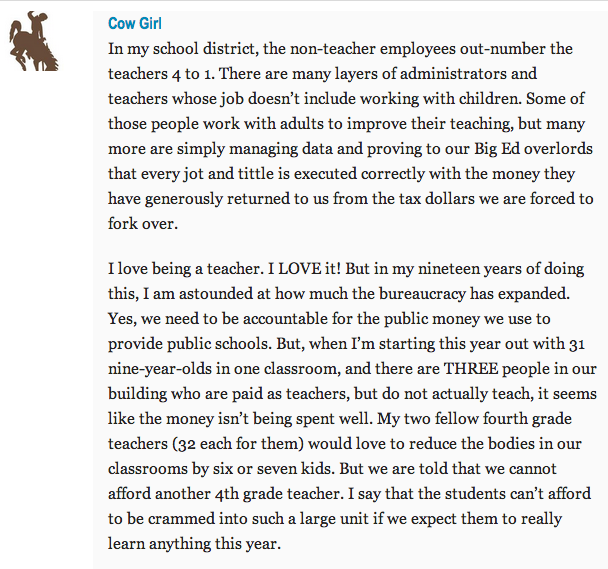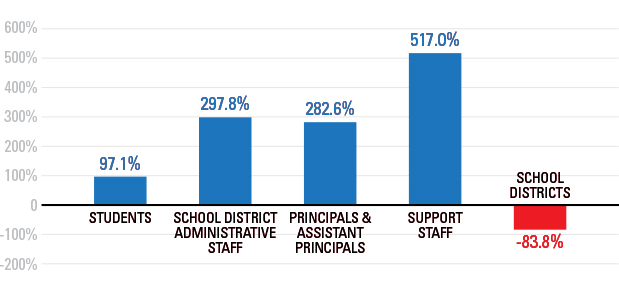Friday Freakout: Teachers Are Tired of Bureaucracy Too
Today’s freakout comes to us from a frustrated teacher in the comments of “Half of All School District Employees Aren’t Teachers” on Ricochet.


Source: The “Fruits” and the Future of Centralization in Public Schools
Additionally, the hiring of administrators and non-teaching staff in public schools, for whatever reason, has increased at a rate nearly three times that of students since 1992—and more than seven times that of students since 1950! That means American public schools have as many non-teaching staff per student as there are teachers per student.
Source: The School Staffing Surge
This phenomenon seems counterintuitive to the arguments made by public school advocates. For instance, they say—and even our survey review of Americans supports—that smaller class sizes could play a key role in improving the educational environment for many public school students. If so many people are on the same page, why haven’t public schools hired more teachers and perhaps fewer non-teachers?
We can’t say for sure, but the lack of autonomy for public schools to do as such is one reason. Anecdotal evidence from teachers like Cow Girl tell us it’s also likely the recent prioritization of new and increased regulations, testing, paperwork, and data mining requirements have also played a role. Private schools that participate in school choice programs are running into this trend in many states as well.
At a certain point, we must ask: Does all of this help students? Or have we let encouraged paper-pushing just to ease some bureaucrats’ minds? Here’s what Americans think.
In a 2014 national survey, 42 percent of Americans and 51 percent of school parents believe children spend 16 or more days doing standardized testing per school year. Another 23 percent said they think kids spend between six and 15 school days testing. That’s 65 percent of Americans that said students endure a week or more of standardized tests. Point being, teachers like Cow Girl are spending considerable time proctoring tests—not utilizing their expertise to educate kids—and who knows how much more time crunching numbers or filling out paperwork.
Moreover, 44 percent of school parents said the amount of testing students and teachers must endure is too much. Only 22 percent of school parents said kids should be doing more testing. If that weren’t enough, most school parents don’t find the tests helpful and none of their main reasons for determining whether a school is a good fit for their children have anything to do with the test scores of that school.
Despite the overwhelming evidence against increased regulations on schools, there doesn’t seem to be any immediate plan by legislators and “Big Ed overlords” to reduce the burden.
In the end, for some districts and schools the sharp and disproportional increase in non-teachers could very well be in response to the piling on of regulations. For others, it could be bloat. For a few, perhaps there is a resistance or lack of knowledge to tech solutions, such as SchoolMint and Blackboard, that could eliminate the inefficiencies that extra regulations often create.
Regardless of the reason, such employment growth reports should force us, as citizens and taxpayers, to ask our districts how they are spending money and our policymakers how they are mandating districts spend money. Is their idea of the right educational team and environment in line with what parents envision for their children? A great way to find out would be by giving them all school choice and the ability to choose perhaps less overregulated schooling models.
Shameless plug: Part III of our report The School Staffing Surge: Decades of Employment Growth in America’s Public Schools is coming in 2015. Be the first to get it by signing up here!




